Yuguang Yao
SuperFlow: Training Flow Matching Models with RL on the Fly
Dec 17, 2025Abstract:Recent progress in flow-based generative models and reinforcement learning (RL) has improved text-image alignment and visual quality. However, current RL training for flow models still has two main problems: (i) GRPO-style fixed per-prompt group sizes ignore variation in sampling importance across prompts, which leads to inefficient sampling and slower training; and (ii) trajectory-level advantages are reused as per-step estimates, which biases credit assignment along the flow. We propose SuperFlow, an RL training framework for flow-based models that adjusts group sizes with variance-aware sampling and computes step-level advantages in a way that is consistent with continuous-time flow dynamics. Empirically, SuperFlow reaches promising performance while using only 5.4% to 56.3% of the original training steps and reduces training time by 5.2% to 16.7% without any architectural changes. On standard text-to-image (T2I) tasks, including text rendering, compositional image generation, and human preference alignment, SuperFlow improves over SD3.5-M by 4.6% to 47.2%, and over Flow-GRPO by 1.7% to 16.0%.
LaTtE-Flow: Layerwise Timestep-Expert Flow-based Transformer
Jun 08, 2025Abstract:Recent advances in multimodal foundation models unifying image understanding and generation have opened exciting avenues for tackling a wide range of vision-language tasks within a single framework. Despite progress, existing unified models typically require extensive pretraining and struggle to achieve the same level of performance compared to models dedicated to each task. Additionally, many of these models suffer from slow image generation speeds, limiting their practical deployment in real-time or resource-constrained settings. In this work, we propose Layerwise Timestep-Expert Flow-based Transformer (LaTtE-Flow), a novel and efficient architecture that unifies image understanding and generation within a single multimodal model. LaTtE-Flow builds upon powerful pretrained Vision-Language Models (VLMs) to inherit strong multimodal understanding capabilities, and extends them with a novel Layerwise Timestep Experts flow-based architecture for efficient image generation. LaTtE-Flow distributes the flow-matching process across specialized groups of Transformer layers, each responsible for a distinct subset of timesteps. This design significantly improves sampling efficiency by activating only a small subset of layers at each sampling timestep. To further enhance performance, we propose a Timestep-Conditioned Residual Attention mechanism for efficient information reuse across layers. Experiments demonstrate that LaTtE-Flow achieves strong performance on multimodal understanding tasks, while achieving competitive image generation quality with around 6x faster inference speed compared to recent unified multimodal models.
R2I-Bench: Benchmarking Reasoning-Driven Text-to-Image Generation
May 29, 2025
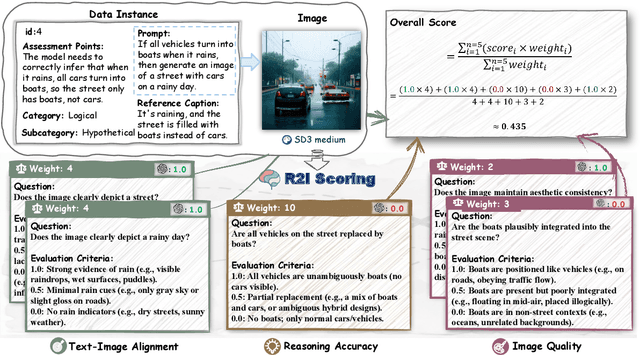
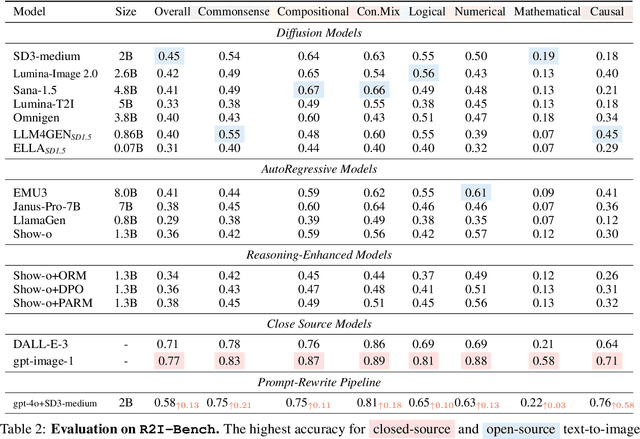
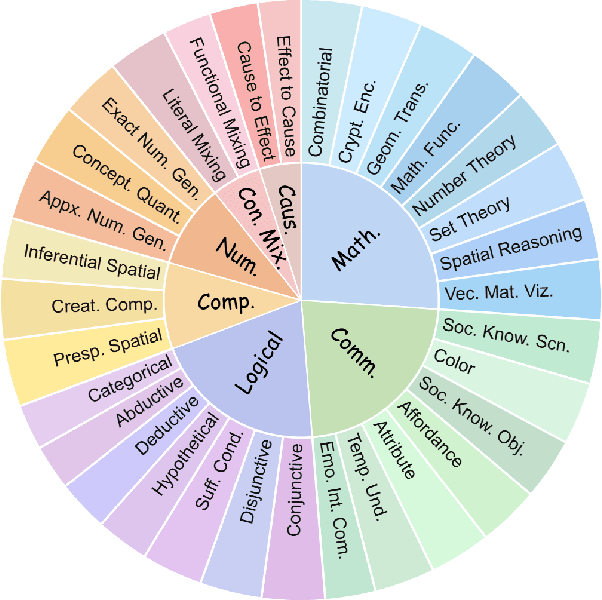
Abstract:Reasoning is a fundamental capability often required in real-world text-to-image (T2I) generation, e.g., generating ``a bitten apple that has been left in the air for more than a week`` necessitates understanding temporal decay and commonsense concepts. While recent T2I models have made impressive progress in producing photorealistic images, their reasoning capability remains underdeveloped and insufficiently evaluated. To bridge this gap, we introduce R2I-Bench, a comprehensive benchmark specifically designed to rigorously assess reasoning-driven T2I generation. R2I-Bench comprises meticulously curated data instances, spanning core reasoning categories, including commonsense, mathematical, logical, compositional, numerical, causal, and concept mixing. To facilitate fine-grained evaluation, we design R2IScore, a QA-style metric based on instance-specific, reasoning-oriented evaluation questions that assess three critical dimensions: text-image alignment, reasoning accuracy, and image quality. Extensive experiments with 16 representative T2I models, including a strong pipeline-based framework that decouples reasoning and generation using the state-of-the-art language and image generation models, demonstrate consistently limited reasoning performance, highlighting the need for more robust, reasoning-aware architectures in the next generation of T2I systems. Project Page: https://r2i-bench.github.io
Safety Mirage: How Spurious Correlations Undermine VLM Safety Fine-tuning
Mar 14, 2025Abstract:Recent vision-language models (VLMs) have made remarkable strides in generative modeling with multimodal inputs, particularly text and images. However, their susceptibility to generating harmful content when exposed to unsafe queries raises critical safety concerns. While current alignment strategies primarily rely on supervised safety fine-tuning with curated datasets, we identify a fundamental limitation we call the "safety mirage" where supervised fine-tuning inadvertently reinforces spurious correlations between superficial textual patterns and safety responses, rather than fostering deep, intrinsic mitigation of harm. We show that these spurious correlations leave fine-tuned VLMs vulnerable even to a simple one-word modification-based attack, where substituting a single word in text queries with a spurious correlation-inducing alternative can effectively bypass safeguards. Additionally, these correlations contribute to the over prudence, causing fine-tuned VLMs to refuse benign queries unnecessarily. To address this issue, we show machine unlearning (MU) as a powerful alternative to supervised safety fine-tuning as it avoids biased feature-label mappings and directly removes harmful knowledge from VLMs while preserving their general capabilities. Extensive evaluations across safety benchmarks show that under one-word attacks, MU-based alignment reduces the attack success rate by up to 60.17% and cuts unnecessary rejections by over 84.20%. Codes are available at https://github.com/OPTML-Group/VLM-Safety-MU. WARNING: There exist AI generations that may be offensive in nature.
FairSkin: Fair Diffusion for Skin Disease Image Generation
Oct 31, 2024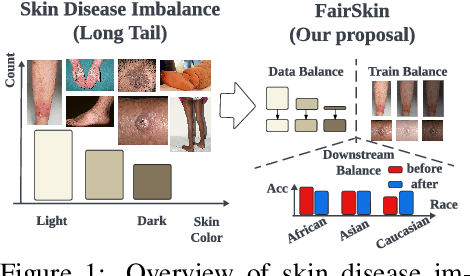

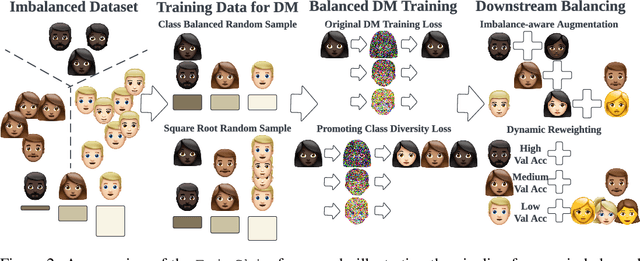

Abstract:Image generation is a prevailing technique for clinical data augmentation for advancing diagnostic accuracy and reducing healthcare disparities. Diffusion Model (DM) has become a leading method in generating synthetic medical images, but it suffers from a critical twofold bias: (1) The quality of images generated for Caucasian individuals is significantly higher, as measured by the Frechet Inception Distance (FID). (2) The ability of the downstream-task learner to learn critical features from disease images varies across different skin tones. These biases pose significant risks, particularly in skin disease detection, where underrepresentation of certain skin tones can lead to misdiagnosis or neglect of specific conditions. To address these challenges, we propose FairSkin, a novel DM framework that mitigates these biases through a three-level resampling mechanism, ensuring fairer representation across racial and disease categories. Our approach significantly improves the diversity and quality of generated images, contributing to more equitable skin disease detection in clinical settings.
Prompt Diffusion Robustifies Any-Modality Prompt Learning
Oct 26, 2024



Abstract:Foundation models enable prompt-based classifiers for zero-shot and few-shot learning. Nonetheless, the conventional method of employing fixed prompts suffers from distributional shifts that negatively impact generalizability to unseen samples. This paper introduces prompt diffusion, which uses a diffusion model to gradually refine the prompts to obtain a customized prompt for each sample. Specifically, we first optimize a collection of prompts to obtain over-fitted prompts per sample. Then, we propose a prompt diffusion model within the prompt space, enabling the training of a generative transition process from a random prompt to its overfitted prompt. As we cannot access the label of a test image during inference, our model gradually generates customized prompts solely from random prompts using our trained, prompt diffusion. Our prompt diffusion is generic, flexible, and modality-agnostic, making it a simple plug-and-play module seamlessly embedded into existing prompt learning methods for textual, visual, or multi-modal prompt learning. Our diffusion model uses a fast ODE-based sampling strategy to optimize test sample prompts in just five steps, offering a good trade-off between performance improvement and computational efficiency. For all prompt learning methods tested, adding prompt diffusion yields more robust results for base-to-new generalization, cross-dataset generalization, and domain generalization in classification tasks tested over 15 diverse datasets.
Adversarial Watermarking for Face Recognition
Sep 24, 2024Abstract:Watermarking is an essential technique for embedding an identifier (i.e., watermark message) within digital images to assert ownership and monitor unauthorized alterations. In face recognition systems, watermarking plays a pivotal role in ensuring data integrity and security. However, an adversary could potentially interfere with the watermarking process, significantly impairing recognition performance. We explore the interaction between watermarking and adversarial attacks on face recognition models. Our findings reveal that while watermarking or input-level perturbation alone may have a negligible effect on recognition accuracy, the combined effect of watermarking and perturbation can result in an adversarial watermarking attack, significantly degrading recognition performance. Specifically, we introduce a novel threat model, the adversarial watermarking attack, which remains stealthy in the absence of watermarking, allowing images to be correctly recognized initially. However, once watermarking is applied, the attack is activated, causing recognition failures. Our study reveals a previously unrecognized vulnerability: adversarial perturbations can exploit the watermark message to evade face recognition systems. Evaluated on the CASIA-WebFace dataset, our proposed adversarial watermarking attack reduces face matching accuracy by 67.2% with an $\ell_\infty$ norm-measured perturbation strength of ${2}/{255}$ and by 95.9% with a strength of ${4}/{255}$.
Hide and Seek: How Does Watermarking Impact Face Recognition?
Apr 29, 2024



Abstract:The recent progress in generative models has revolutionized the synthesis of highly realistic images, including face images. This technological development has undoubtedly helped face recognition, such as training data augmentation for higher recognition accuracy and data privacy. However, it has also introduced novel challenges concerning the responsible use and proper attribution of computer generated images. We investigate the impact of digital watermarking, a technique for embedding ownership signatures into images, on the effectiveness of face recognition models. We propose a comprehensive pipeline that integrates face image generation, watermarking, and face recognition to systematically examine this question. The proposed watermarking scheme, based on an encoder-decoder architecture, successfully embeds and recovers signatures from both real and synthetic face images while preserving their visual fidelity. Through extensive experiments, we unveil that while watermarking enables robust image attribution, it results in a slight decline in face recognition accuracy, particularly evident for face images with challenging poses and expressions. Additionally, we find that directly training face recognition models on watermarked images offers only a limited alleviation of this performance decline. Our findings underscore the intricate trade off between watermarking and face recognition accuracy. This work represents a pivotal step towards the responsible utilization of generative models in face recognition and serves to initiate discussions regarding the broader implications of watermarking in biometrics.
Backdoor Secrets Unveiled: Identifying Backdoor Data with Optimized Scaled Prediction Consistency
Mar 15, 2024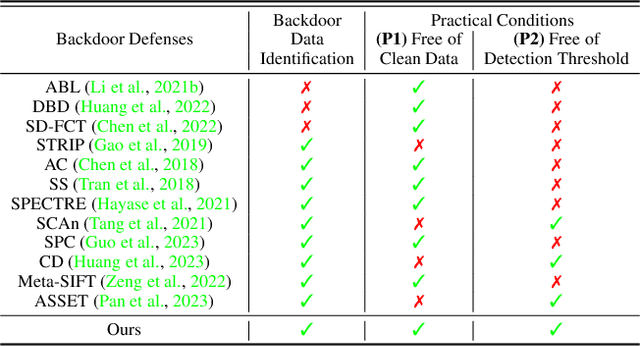

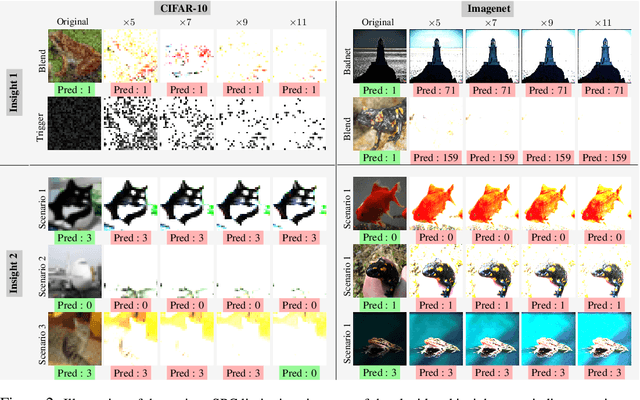
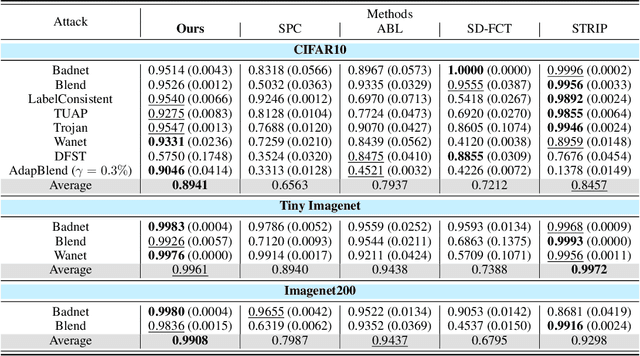
Abstract:Modern machine learning (ML) systems demand substantial training data, often resorting to external sources. Nevertheless, this practice renders them vulnerable to backdoor poisoning attacks. Prior backdoor defense strategies have primarily focused on the identification of backdoored models or poisoned data characteristics, typically operating under the assumption of access to clean data. In this work, we delve into a relatively underexplored challenge: the automatic identification of backdoor data within a poisoned dataset, all under realistic conditions, i.e., without the need for additional clean data or without manually defining a threshold for backdoor detection. We draw an inspiration from the scaled prediction consistency (SPC) technique, which exploits the prediction invariance of poisoned data to an input scaling factor. Based on this, we pose the backdoor data identification problem as a hierarchical data splitting optimization problem, leveraging a novel SPC-based loss function as the primary optimization objective. Our innovation unfolds in several key aspects. First, we revisit the vanilla SPC method, unveiling its limitations in addressing the proposed backdoor identification problem. Subsequently, we develop a bi-level optimization-based approach to precisely identify backdoor data by minimizing the advanced SPC loss. Finally, we demonstrate the efficacy of our proposal against a spectrum of backdoor attacks, encompassing basic label-corrupted attacks as well as more sophisticated clean-label attacks, evaluated across various benchmark datasets. Experiment results show that our approach often surpasses the performance of current baselines in identifying backdoor data points, resulting in about 4%-36% improvement in average AUROC. Codes are available at https://github.com/OPTML-Group/BackdoorMSPC.
UnlearnCanvas: A Stylized Image Dataset to Benchmark Machine Unlearning for Diffusion Models
Feb 26, 2024Abstract:The rapid advancement of diffusion models (DMs) has not only transformed various real-world industries but has also introduced negative societal concerns, including the generation of harmful content, copyright disputes, and the rise of stereotypes and biases. To mitigate these issues, machine unlearning (MU) has emerged as a potential solution, demonstrating its ability to remove undesired generative capabilities of DMs in various applications. However, by examining existing MU evaluation methods, we uncover several key challenges that can result in incomplete, inaccurate, or biased evaluations for MU in DMs. To address them, we enhance the evaluation metrics for MU, including the introduction of an often-overlooked retainability measurement for DMs post-unlearning. Additionally, we introduce UnlearnCanvas, a comprehensive high-resolution stylized image dataset that facilitates us to evaluate the unlearning of artistic painting styles in conjunction with associated image objects. We show that this dataset plays a pivotal role in establishing a standardized and automated evaluation framework for MU techniques on DMs, featuring 7 quantitative metrics to address various aspects of unlearning effectiveness. Through extensive experiments, we benchmark 5 state-of-the-art MU methods, revealing novel insights into their pros and cons, and the underlying unlearning mechanisms. Furthermore, we demonstrate the potential of UnlearnCanvas to benchmark other generative modeling tasks, such as style transfer. The UnlearnCanvas dataset, benchmark, and the codes to reproduce all the results in this work can be found at https://github.com/OPTML-Group/UnlearnCanvas.
 Add to Chrome
Add to Chrome Add to Firefox
Add to Firefox Add to Edge
Add to Edge